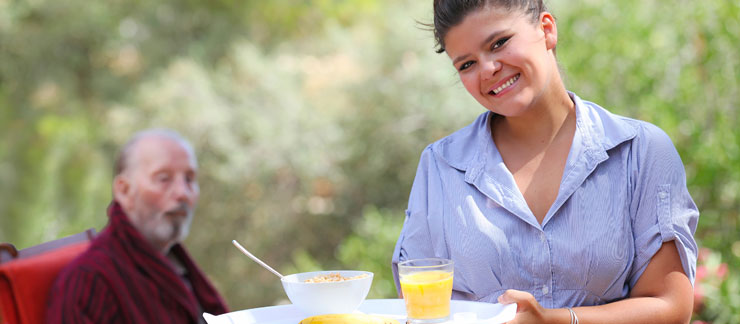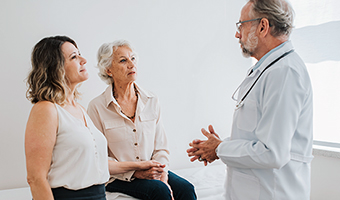How Professional Caregivers Can Help Facilitate Proper Diets
There are few greater joys than when a senior loved one is discharged from the hospital or rehabilitation facility and returns to the comfort of home. Following this short-lived celebration are more tasks to maintain wellness and quality of life. Typically, your loved one is released with a care plan created by a doctor, and that may involve changes to your loved one’s diet.
There are all kinds of different scenarios that can affect a senior’s diet. A senior yearning for salty and sweet comfort food may be in for a surprise if the care plan includes a diet that drastically reduces the intake of both. On the other hand, he or she may not be eating as much and may be losing weight. Licensed nutritionist and professional caregiver Kathy Warwick says it is common for seniors to return home from the hospital and lack an appetite.
“Depression is a major reason that older adults stop eating and lose weight, (so) caregivers can be instrumental in recognizing the symptoms of depression and providing social support during the recovery period,” says Warwick, of Jackson, Mississippi.
Aging Comes With Changing Taste Buds, Dehydration Risk
In her daily practice of caring for seniors, Warwick reminds family caregivers of the importance of hydration and making sure their senior loved one drinks enough water and healthy beverages. "Adequate fluid intake is essential for all bodily functions," Warwick says. "Experienced professional caregivers know to look for symptoms such as fatigue, weakness, dizziness and perhaps constipation.” And older adults’ dietary needs differ from a younger person’s needs because the natural thirst mechanism that prompts someone to drink enough fluids does not function well as adults age. Too much salt is especially bad for seniors, but they often want foods with more of it because of diminished taste buds.
Sugar and salt intake are automatically worth monitoring. “You have to watch for dark yellow or brownish color urine and encourage elders to drink a variety of fluids all through the day,” Warwick says. “If clients have a diagnosis of diabetes, beverages need to be mostly sugar-free.”
For seniors diagnosed with high blood pressure, congestive heart failure or kidney disease, limiting sodium intake in the diet will help control these conditions. Unfortunately, Warwick says, elders tend to lose the ability to taste certain foods, so they miss the added salt. The Institute of Medicine's Food and Nutrition Board recommends that adults between the ages of 51 and 70 consume no more than 1.3 grams of sodium per day, which is about half a teaspoon of salt. Seniors older than 71 should limit themselves to 1.2 grams.
The professional caregiver serves as an accountability partner because a proper diet can be critical in addressing specific issues – especially if outlined in a care plan. It is essential to be aware of some potential food-drug interactions because some medications should be taken with food and others taken on an empty stomach for the medicine to work best. Foods high in vitamin K, for example, can keep blood thinners from working as they should. For instance, “If the older adult enjoys eating turnip greens, spinach or broccoli, they should eat them two to three times a week every week so that blood thinners can be adjusted accordingly,” Warwick says.
A professional caregiver can work with your senior loved one in ensuring the senior accesses fresh fruits and vegetables, from various sources, because that person will know with what the elder’s medications will not adversely interact. Furthermore, caregivers should know about the role of carbohydrates in a healthy eating plan and how different foods can affect blood sugars.
Foods high in carbohydrates include starches, bread, cereals, grains, fruit, fruit juices, milk, desserts, sweets and candy. "This does not mean you have to exclude these foods, but it is important to limit portion sizes and to spread the carbohydrate intake out over the day as evenly as possible,” Warwick says. “In planning meals, keep in mind that starchy vegetables such as corn, lima beans, black-eyed peas, sweet green peas, sweet potatoes, and pinto beans are all counted as carbohydrates.”
Seek recipe help online, visit a local Farmers’ Market to learn from a farmer or producer about ways to prepare healthy dishes and utilize MyPlate for Older Adults. The MyPlate guide accounts for the unique dietary needs of seniors while suggesting increased fluid intake and using herbs and spices for flavorful meals without excess salt and sugar. The professional caregiver can post the MyPlate guide on the refrigerator to help the family caregiver prepare balanced meals.
This tool is part of the AARP Foundation’s long-term strategy to overcome food insecurity among older adults. More American seniors deal with food insecurity – that is, lack of access to fresh fruits and vegetables and other healthful foods. The rate of food insecurity among older Americans has more than doubled since 2001, putting more than 10 million older individuals at risk of going hungry every day.
“Keep in mind that though some seniors may need more care with everyday tasks, they are not children - they are adults with many years of wisdom and experience,” Warwick adds. “Elders have the right to refuse any or all treatment and dietary restrictions if they choose.”
Why a Professional Caregiver is a Great Resource to Help Facilitate a Healthy Diet
A caregiver is a great resource to help facilitate a healthy diet. They can encourage seniors to try new foods, and their experience equips them with the tactics necessary to make this task easier. “Many seniors resist the idea of a special diet (because) a strict diet may be unnecessary and burdensome,” says Warwick. “Some elders may decide they do not care to adhere to a strict diet. Sometimes there are small changes they are willing to make, and those should be the first focus.
After the senior and the caregiver become acquainted with MyPlate, or a care plan that outlines a diet, the caregiver can help them create a grocery list of new foods to try. Warwick suggests including superfoods containing high levels of nutrients and minerals that build the immune system and boost metabolism. “One way to include some superfoods is to prepare a smoothie with high-protein Greek yogurt, assorted frozen berries and a handful of raw baby spinach,” she says. “A smoothie is great for someone who is having difficulty chewing or swallowing. Sometimes radiation treatment for cancer can cause pain in the mouth or esophagus and a smoothie can provide great nutrition while soothing the throat.”
For more information on how a professional caregiver can help your senior loved one maintain healthy body weight, click here.














